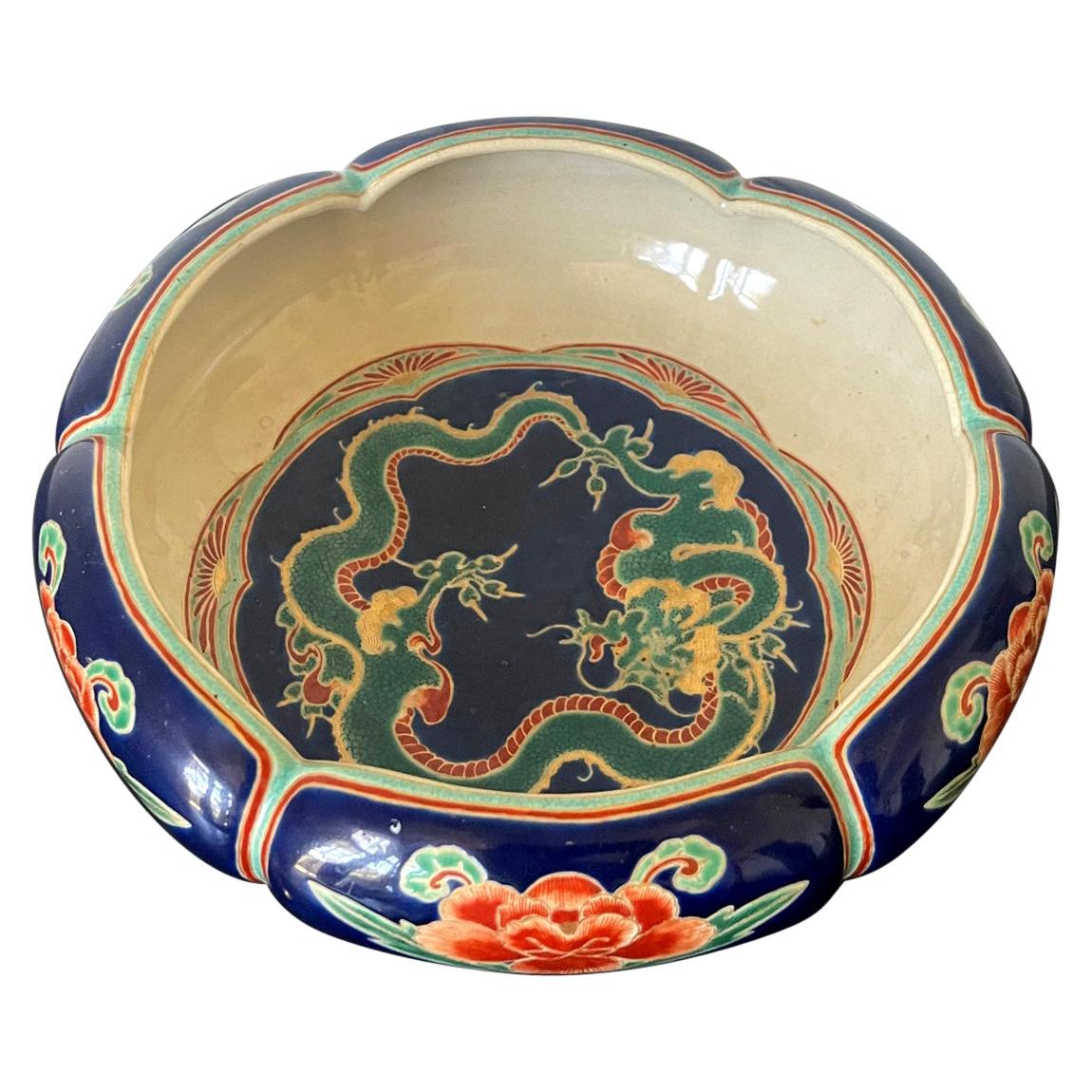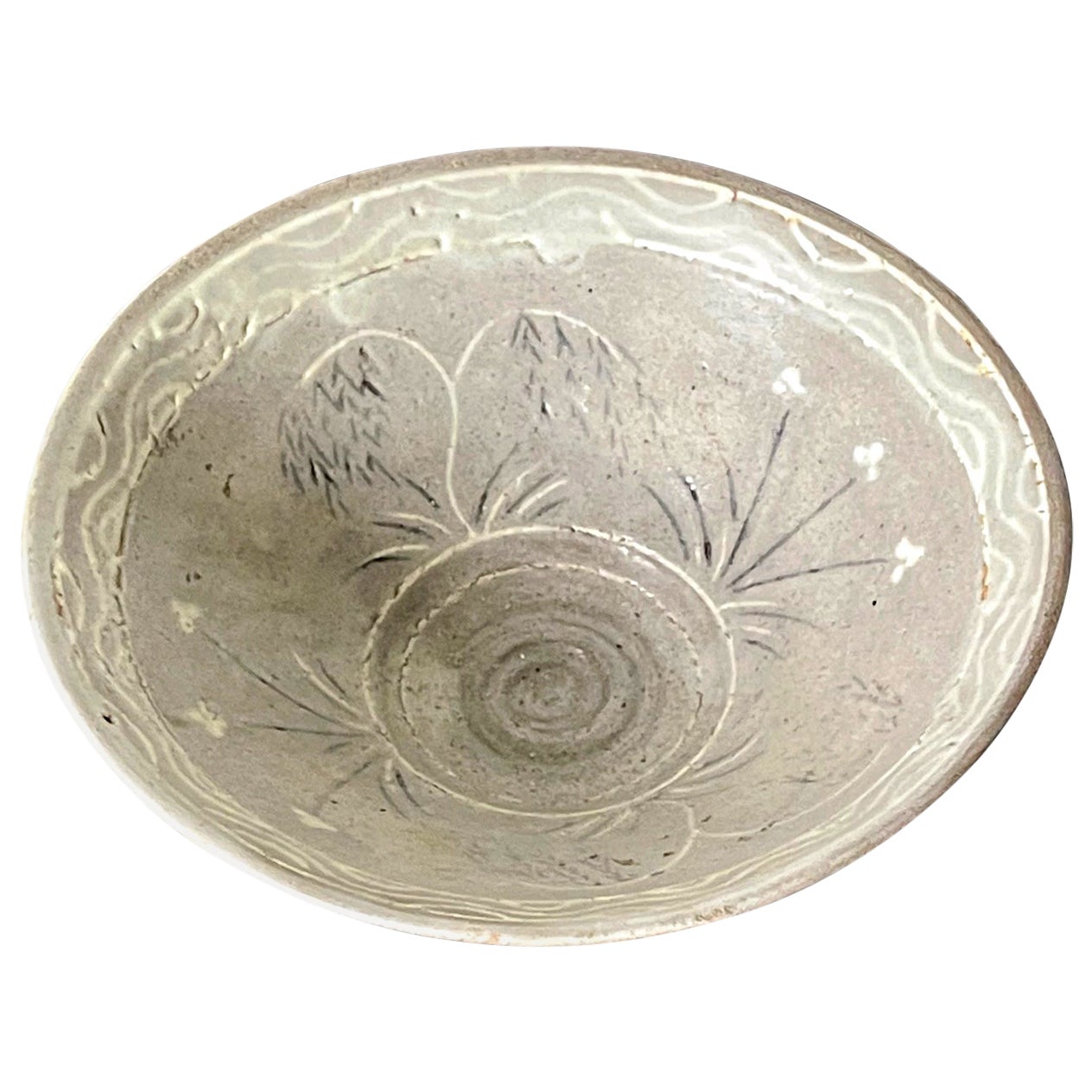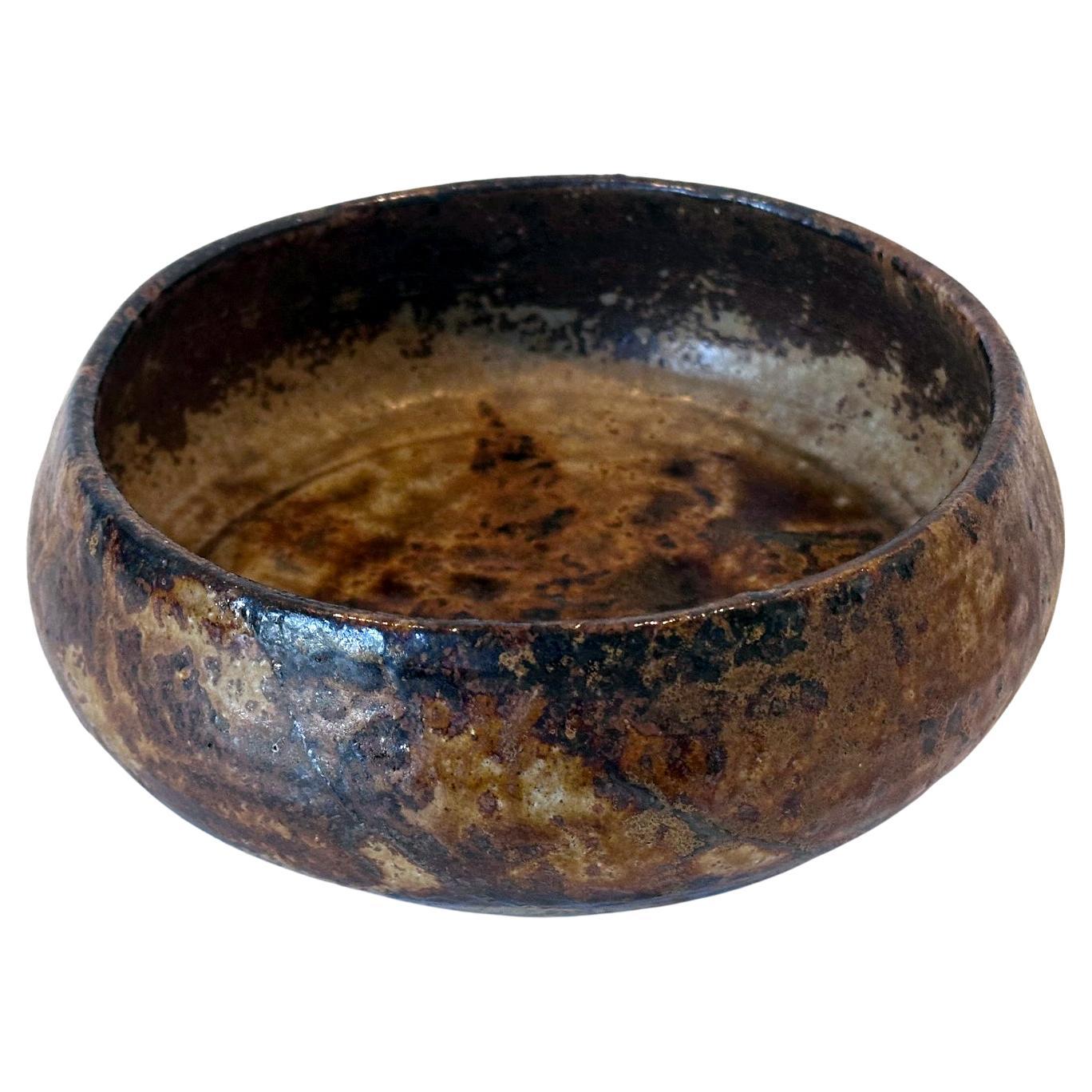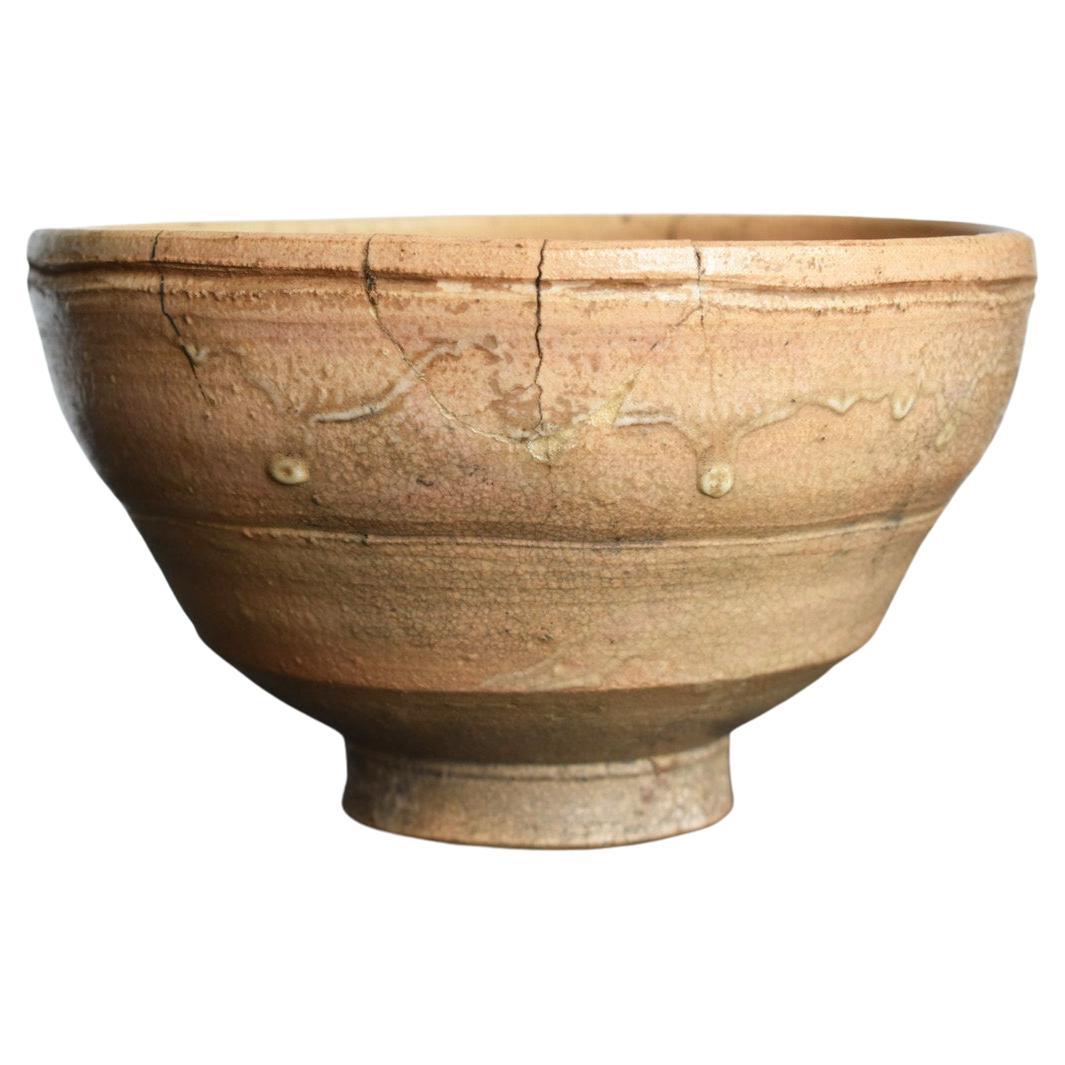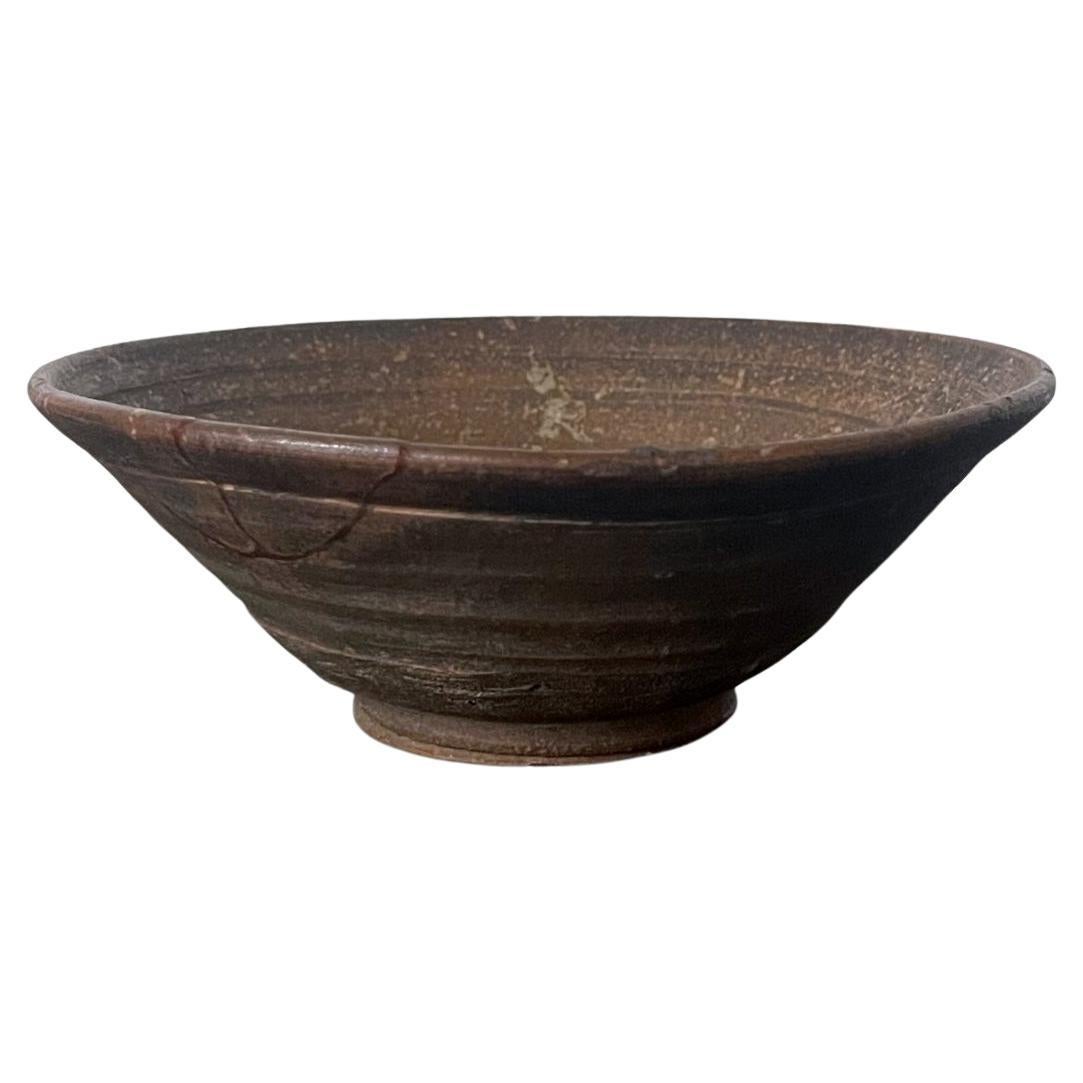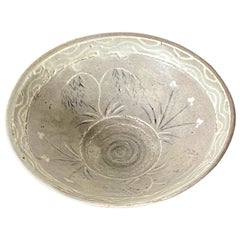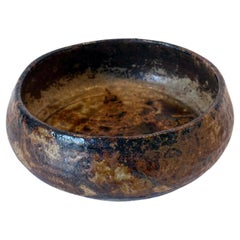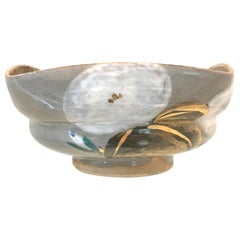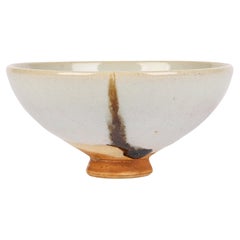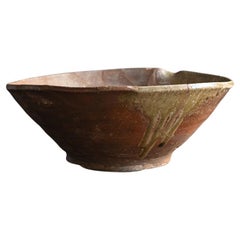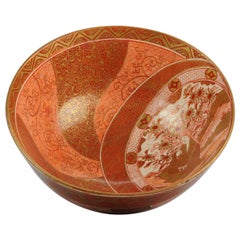Items Similar to Japanese Ceramic Bowl with Crescent Mark by Kodai-ji Kiln Meiji Period Ex-Musuem
Want more images or videos?
Request additional images or videos from the seller
1 of 13
Japanese Ceramic Bowl with Crescent Mark by Kodai-ji Kiln Meiji Period Ex-Musuem
$1,850
£1,404.49
€1,606.44
CA$2,584.72
A$2,874.77
CHF 1,501.12
MX$34,982.90
NOK 19,171.54
SEK 17,979.52
DKK 11,989.44
Shipping
Retrieving quote...The 1stDibs Promise:
Authenticity Guarantee,
Money-Back Guarantee,
24-Hour Cancellation
About the Item
An unusually shaped ceramic chawan made by Kodai-ji Kiln in Kyoto circa 19th century of Meiji Period. The bowl has a rounded shape of a monk's alms bowl supported by a short foot ring, but it has a square mouth opening. The exterior features carved lines of chevron pattern. Covered completely in a coral pink glaze except the base, the bottom well of the interior has a curious mark of crescent moon in a light-yellow color. The bowl was possibly used as a Haiki (ash bowl) during tea ceremony (chado), and one can only imagine how the moon plays hide and seek in the dark green tea during the leisurely process. As the accouterments of Japanese tea ceremony is highly attuned to the seasonal change, the specific crescent design indicates that the bowl may be only used on the new moon phase of the month. The unglazed base was branded with a seal mark "Kodai-ji". The mark is associated with Rokurokudo, a ceramic maker in Kyoto that is still in business today. We can't be entirely sure when the bowl was made but it was likely in the late Meiji Period around 1900s.
The bowl was in the collection of Yale University Art Gallery and still bears a paper label 1170A as shown.
It comes with a digital copy of the museum card of its provenance and history.
About the maker:
The first-generation Rokurokudo master opened his own pottery kiln in Entoku-in Temple (a sub-temple of Kodai-ji Temple) in the Higashiyama district. He gave his pottery works the name Kodaiji-yaki. Later, the kiln was moved to Sannenzaka Street, just by the famous Kiyomizu Temple, and Rokurokudo created fine Kyo-yaki and Kiyomizu-yaki pottery works as a manufacturer throughout the Meiji, Taisho and Showa periods.
- Dimensions:Height: 2.75 in (6.99 cm)Diameter: 5.75 in (14.61 cm)
- Style:Meiji (Of the Period)
- Materials and Techniques:Ceramic,Glazed
- Place of Origin:
- Period:
- Date of Manufacture:19th century
- Condition:Wear consistent with age and use. Fine with minimal shelf wear.
- Seller Location:Atlanta, GA
- Reference Number:1stDibs: LU945044105482
About the Seller
4.9
Platinum Seller
Premium sellers with a 4.7+ rating and 24-hour response times
Established in 2006
1stDibs seller since 2010
564 sales on 1stDibs
Typical response time: <1 hour
- ShippingRetrieving quote...Shipping from: Atlanta, GA
- Return Policy
Authenticity Guarantee
In the unlikely event there’s an issue with an item’s authenticity, contact us within 1 year for a full refund. DetailsMoney-Back Guarantee
If your item is not as described, is damaged in transit, or does not arrive, contact us within 7 days for a full refund. Details24-Hour Cancellation
You have a 24-hour grace period in which to reconsider your purchase, with no questions asked.Vetted Professional Sellers
Our world-class sellers must adhere to strict standards for service and quality, maintaining the integrity of our listings.Price-Match Guarantee
If you find that a seller listed the same item for a lower price elsewhere, we’ll match it.Trusted Global Delivery
Our best-in-class carrier network provides specialized shipping options worldwide, including custom delivery.More From This Seller
View AllRare Japanese Ceramic Glazed Bowl Makuzu Kozan Meiji Period
By Makuzu Kozan
Located in Atlanta, GA
On offer is a rare ceramic bowl with overglazed design by the famed Japanese ceramic artist Makuzu Kozan (1842-1916), circa 1906-1916. The bowl is rather unusual from the potter's repertoire with its unique glaze colors and decoration, and it likely belonged to a small series that Kozan made in and after 1906. A bowl of similar glaze and nearly identical dragon motif was recorded as a diplomatic present to the British royalty Arthur Connaught (1883-1932) when he represented King Gorge V in Japan in 1906. Other pieces, such as this bowl, were likely made with similar materials and designs afterwards.
Essentially round in form, the bowl has a generous volume with six harmonious lobes. The bottom of the interior showcases a coiled dragon in red, green and gold slithering on a cobalt blue background. The roundel shares an echoing lobed perimeter, which is further outlined by red and turquois bands and rising sun design. The exterior of the bowl features six stylized Japanese camellias...
Category
Antique Early 1900s Japanese Japonisme Ceramics
Materials
Ceramic
Korean Ceramic Tea Bowl with Slip Inlays Goryeo Dynasty
Located in Atlanta, GA
A small ceramic conical form tea bowl from Korean Goryeo Dynasty circa 14th century. The bowl is of a slightly irregular shape and covered in a grayish overglaze. The inlaid slip dec...
Category
Antique 15th Century and Earlier Korean Archaistic Ceramics
Materials
Ceramic
Japanese Glazed Stoneware Bowl by Kitaoji Rosanjin Ex-Musuem Collection
By Rosanjin Kitaoji
Located in Atlanta, GA
A stoneware round bowl with dramatic glaze made by Kitaoji Rosanjin (1883-1959) circa first half of the 20th century. The low height bowl with wide opening and swell body resembles a...
Category
Mid-20th Century Japanese Modern Ceramics
Materials
Ceramic
Japanese Ceramic Bowl Makuzu Kozan Utusushi Kenzan
By Makuzu Kozan
Located in Atlanta, GA
A rare ceramic bowl with overglaze paint decoration by Japanese imperial potter Makuzu Kozan ((1842–1916). Unlike the better-known works Kozan made for the expositions in the west and export to the foreign market, this piece exemplifies his work for the domestic market and the tea ceremony. The bowl was made in the so called "Utusushi" Ogata Kenzan (1663-1743), a celebrated Edo painter and ceramicist. Utusushi is loosely translated as "in the spirit of". It is not at all a simple imitation of a master, but a Japanese concept of embracing the spiritual essence of a master while the creator is free to mix in his or her own unique artistic interpretation and flavor.
The bowl was made to hold fruits during the tea ceremony. It has a very distinguished form with a circular lower body morphing into a square upper portion that further opening with flared rim. The surface has a grey glaze onto which Asagao flowers (Japanese morning glory) on the vines were painted in a free and poetic style. White was used for the petals, green for the leaves with touches of gold highlight. Asagao, the symbol of the summer was rendered in the spirit of Ogata Kenzan, and interestingly the shape of the blossom echoes the unique form the bowl. It was likely reserved for the tea ceremony during the summer months.
Under the base, Kozan was signed in black on a white porcelain plaque inlay.
For two similar examples of Kozan's work Utusushi Kenzan, see Page 168-169 of the book: Sekai ni Aisa Reta ya Kimono Miyagawa Kozan Makuzu...
Category
Antique Early 1900s Japanese Japonisme Ceramics
Materials
Ceramic
Korean Ceramic Kakinoheta Chawan Tea Bowl
Located in Atlanta, GA
A "Kakinoheta" type ceramic chawan (tea bowl) made in Korean during Joseon dynasty circa 16th-17th century. The bowl has a slight irregular flat shape w...
Category
Antique 17th Century Korean Other Ceramics
Materials
Ceramic
Korean Ceramic Buncheong Ware Tea Bowl Early Joseon Dynasty
Located in Atlanta, GA
An antique Korean Buncheong stoneware tea bowl (chawan) from early Joseon Dynasty circa late 15th to early 16th century. The bowl with a short ring base is nearly entirely covered in a white slip except the base (known as sougusuri in Japanese, total glaze). Iron-colored scrolling vines were painted on with quick and deft brush strokes, rendering the bowl a vital and spontaneous appeal. It appears that the bowl was dipped in the white slip instead of being brushed on, observing from the slip pattern left on the rim of the bowl. The bowl shows significant age and evident of use for tea drinking. There are losses of glaze flakes throughout, along the rim and inside the bowl. The flake off the glaze left a dark spot on the rim, exposing the deep colored clay underneath. Inside the bowl, many of the glaze flakes appear more superficial and retains a yellowing color from the tea stains (known as amamori, rain leak). There is a historical crack line on the exterior (surface only) that result in associated small losses of glaze. It appears that the crack line was the result from the kiln firing and gradually the glaze around it started to reduce. The bowl comes with a later wrapping cloth and a wood tomobako box, but they are not original to the piece.
This particular type of Buncheong ware was associated with the Hakbong-ri kilns in the sacred Mount Gyeryong Mountains, west of Daejeon city in the Chungcheong province. During early Joseon Dynasty, the emperor decided to reject Buddhism to embrace the Confucianism. As a result, many monks were forced to abandon their religious life and returned to the secular society. The monks in Gyeryong mountains set up the kilns and started to produce this so called "Hakbong-ri" type of Buncheong ware. The production was shorted-lived for only a few decades from late 15th to early 16th century before it turned to porcelain, but the ware made during that period was noted for their fresh and enigmatic appeal with deft iron-paint decoration. Collectors cherish these rare pieces for their vitality and spontaneity often used them on important occasions of chado in Japan and passed down to generation.
For a similar bowl, see Catalog 52 illustrated on page 87 of the book "Korean Buncheong Ceramics...
Category
Antique 15th Century and Earlier Korean Archaistic Ceramics
Materials
Ceramic
You May Also Like
Japanese Antique Earthenware Tea Bowl/Edo Period/1700-1800/'Hagi Ware'
Located in Sammu-shi, Chiba
This is Hagi ware made in the middle of the Edo period.
Hagi ware is a type of pottery that began in Hagi City, Yamaguchi Prefecture in the early Edo period...
Category
Antique 18th Century Japanese Edo Pottery
Materials
Pottery
Chinese Jun Ware Streak Glazed Art Pottery Bowl
Located in Bishop's Stortford, Hertfordshire
A very stylish good quality Chinese Jun Ware pottery bowl decorated with streaked glazes on a red and pale blue glazed ground dating from the latter 19th o...
Category
Antique 19th Century Chinese Other Ceramics
Materials
Pottery
Japanese antique pottery bowl/Tokoname ware/12th-13th century/excavated pottery
Located in Sammu-shi, Chiba
This is a pottery called Tokoname ware.
Tokoname is a kiln located in Aichi Prefecture, Japan (Tokoname Kiln is marked with a red circle on the map).
It is said to have originated ar...
Category
Antique 15th Century and Earlier Japanese Other Decorative Bowls
Materials
Pottery
Antique 19th Century Japanese Kutani Bowl Marked on Base Figures Garden
Located in Amsterdam, Noord Holland
Large and very lovely piece. With mark
Condition
Overall condition 1 restored chip. Size: 235mm x 100mm
Period
Meiji Periode (1867-1912).
Category
Antique 19th Century Japanese Meiji Ceramics
Materials
Earthenware
$718 Sale Price
20% Off
Shinbei Sakakura X (10th) Japanese Hagi Yaki Ware Pottery Chawan Tea Bowl & Box
Located in Studio City, CA
A wonderfully hand crafted and beautifully glazed Hagi Yaki Ware Chawan tea bowl by the 10th Shinbei Sakakura (X). This piece has quite a special feel to it. The Chawan radiates i...
Category
Antique Mid-19th Century Japanese Edo Ceramics
Materials
Pottery, Stoneware
Korean Joseon Dynasty Glazed Pottery Ceramic Hakame Chawan Tea Bowl Dish
Located in Studio City, CA
A wonderful Joseon Dynasty (1392-1897) Korean pottery bowl/ dish with a beautiful muted glaze, color, and nicely aged patina.
As this is not our area of expertise, we are listing...
Category
Antique 19th Century Korean Ceramics
Materials
Pottery
More Ways To Browse
Antique Furniture Makers Mark
Mark Bowles
Used Kiln Furniture
Pink Glaze
Antique Kilns
Kiln Japanese
Used Ceramic Kilns
Japanese Antique Marks
Japanese Labels
Japanese Coral
Japanese Tea Ceremony
Japanese Maker Marks
Ceramic Coral
Japanese Monk
Ceramic Bowl Yellow
Antique Pink Bowl
Antique Japanese Rings
Late Mayers Pottery
